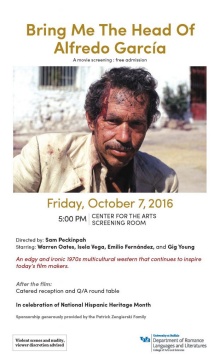Zengierski Family Lecture in Spanish Language and Culture
This year’s Zengierski Family Spanish Language and Literature Lecture was a projection with round-table and reception that coincided with National Hispanic Heritage Month. It was held on Friday, Oct. 7, at 5:00pm in the Center for the Arts Screening Room.
The film was Sam Peckinpah’s Bring Me the Head of Alfredo García (1974). A growing critical and popular consensus holds that this transnational western-shot-in-Mexico is a classic, a unique combination of U.S. and Mexican talent, showcasing Hispanic stars such as Isela Vega and Emilio “El Indio” Fernández—albeit with problematic messages concerning ethnicity, gender, and sexuality. The Toronto International Film Festival and Lincoln Center in Manhattan both devoted special screenings to it this year. Our showing was free thanks to the generosity of Father Patrick Zengierski, and came with a complimentary roundtable with several RLL graduate students, and a spread of Mexican-themed food by Three Pillars catering.
The movie’s plot is set in motion when an underworld big wheel places a bounty on the head of the man who left his daughter pregnant. A down-on-his-luck American piano player and his Mexican girlfriend become involved in the race for the reward, taking them from Mexico City through rural areas (Cuernavaca). The film is edgy, with violent scenes and nudity. Peckinpah is a forerunner for Quentin Tarantino and John Woo; hence his films may not be advisable for those who are upset by representations of trauma. However, Bring Me the Head of Alfredo García is increasingly considered a 20th century masterpiece. Peckinpah said that he wanted to make a film about contemporary Mexico; this is the result.
